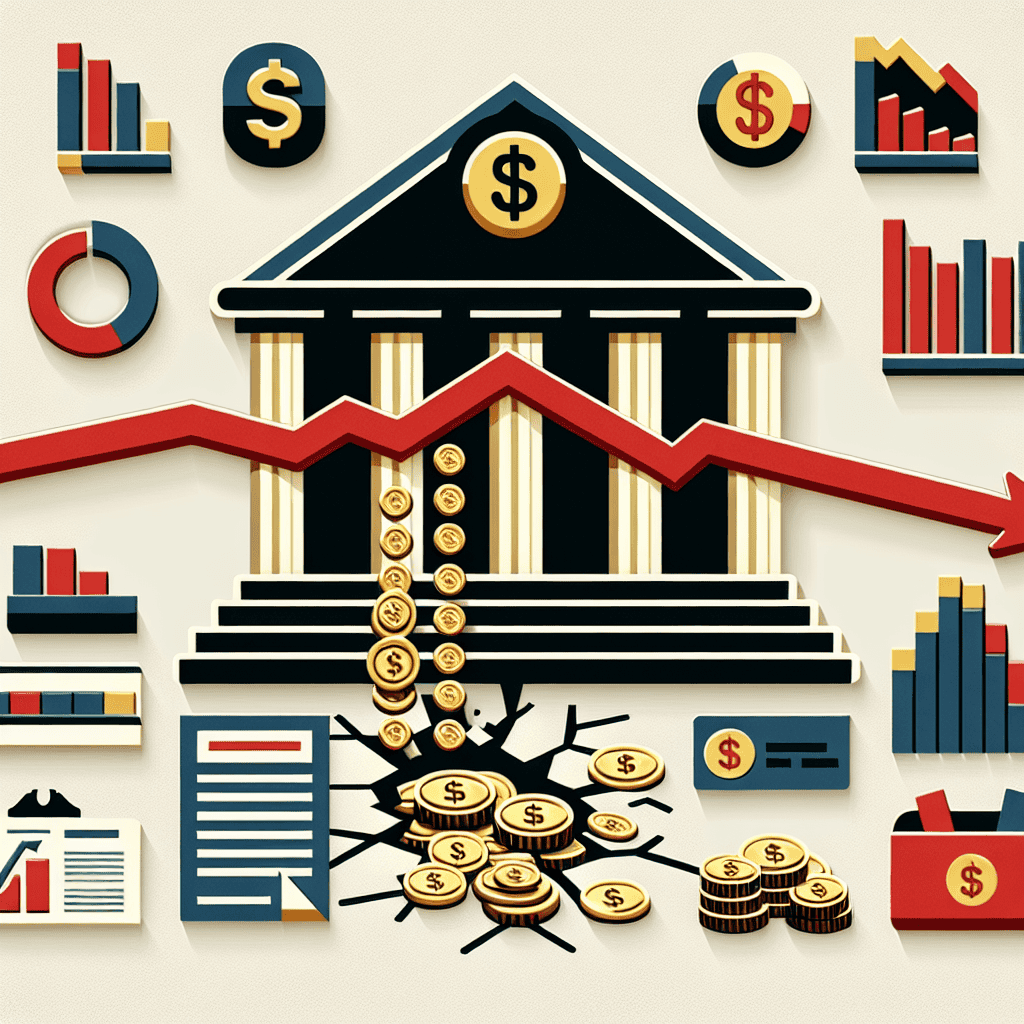“Tesla’s Earnings: Navigate the 15% Dip – Is It Time to Buy or Sell?”
Introduction
In October, Tesla’s stock experienced a significant decline of 15%, drawing attention to the company’s earnings as a pivotal factor influencing investor sentiment. As one of the most closely watched companies in the stock market, Tesla’s financial performance and strategic decisions are under intense scrutiny. The recent drop in stock value raises critical questions for investors: Is this a temporary setback or a signal of deeper issues? Should investors view this dip as a buying opportunity, or is it a warning to sell? Analyzing Tesla’s earnings, market position, and future prospects is essential for making informed investment decisions in this volatile environment.
Analyzing Tesla’s Q3 Earnings: Key Takeaways for Investors
Tesla’s third-quarter earnings report has become a focal point for investors, especially as the company’s stock experienced a significant 15% drop in October. This decline has prompted a critical evaluation of Tesla’s financial health and future prospects, raising the question of whether it is time to buy or sell. As investors scrutinize the Q3 earnings, several key takeaways emerge that could influence their decision-making process.
To begin with, Tesla’s revenue growth remains a central aspect of its financial performance. In the third quarter, the company reported revenues that, while impressive, fell slightly short of analysts’ expectations. This shortfall can be attributed to a combination of factors, including supply chain disruptions and increased competition in the electric vehicle market. Despite these challenges, Tesla’s ability to maintain a robust revenue stream underscores its resilience and market leadership. However, the gap between expectations and actual performance has raised concerns about the company’s ability to sustain its growth trajectory in the face of mounting pressures.
Moreover, Tesla’s profitability continues to be a topic of interest for investors. The company’s net income for the third quarter showed a modest increase compared to the previous year, reflecting its ongoing efforts to optimize production and reduce costs. Nevertheless, the profit margins have been under pressure due to rising raw material costs and the need for substantial investments in new technologies and infrastructure. These factors have led to a more cautious outlook on Tesla’s profitability in the near term, prompting investors to weigh the potential risks against the long-term benefits of holding the stock.
In addition to financial metrics, Tesla’s strategic initiatives play a crucial role in shaping investor sentiment. The company’s commitment to expanding its production capacity, particularly with the opening of new Gigafactories, signals its intent to capture a larger share of the global electric vehicle market. Furthermore, Tesla’s advancements in autonomous driving technology and energy solutions highlight its ambition to diversify its revenue streams and reduce dependency on vehicle sales alone. These strategic moves are likely to bolster investor confidence, provided they translate into tangible results in the coming quarters.
Another critical factor influencing investor decisions is the broader market environment. The electric vehicle sector is witnessing rapid growth, with traditional automakers and new entrants intensifying competition. This dynamic landscape necessitates that Tesla not only maintains its innovation edge but also adapts swiftly to changing market conditions. Additionally, macroeconomic factors such as interest rate fluctuations and geopolitical tensions could impact consumer demand and supply chain stability, further complicating the investment landscape for Tesla.
In light of these considerations, the decision to buy or sell Tesla stock hinges on an investor’s risk tolerance and investment horizon. For those with a long-term perspective, Tesla’s strong brand, technological leadership, and strategic initiatives may present a compelling case for holding or even increasing their stake. Conversely, investors with a shorter-term focus might be wary of the stock’s volatility and the potential for further declines, opting to sell or reduce their exposure.
Ultimately, Tesla’s Q3 earnings report provides valuable insights into the company’s current standing and future prospects. While challenges persist, the company’s resilience and strategic vision offer a foundation for potential growth. As investors navigate the complexities of the market, a balanced assessment of Tesla’s financial performance, strategic initiatives, and external factors will be essential in making informed investment decisions.
The Impact of Tesla’s Earnings on Stock Performance
Tesla’s earnings reports have long been a focal point for investors and analysts alike, serving as a barometer for the company’s financial health and future prospects. In October, Tesla’s stock experienced a significant decline of 15%, prompting a renewed examination of the company’s earnings and their impact on stock performance. This downturn has raised critical questions about whether investors should consider buying or selling Tesla shares, making it imperative to understand the underlying factors influencing this decision.
To begin with, Tesla’s earnings reports provide a comprehensive overview of the company’s revenue, profit margins, and overall financial stability. These reports are crucial for investors as they offer insights into Tesla’s ability to sustain growth and profitability in a highly competitive market. In recent years, Tesla has consistently demonstrated robust revenue growth, driven by increased vehicle deliveries and expansion into new markets. However, the company’s profitability has been a subject of debate, with fluctuating margins and significant capital expenditures impacting net income.
The recent 15% drop in Tesla’s stock price can be attributed to several factors, including market volatility and investor sentiment. However, a closer examination of the company’s earnings reveals additional layers of complexity. For instance, while Tesla has made strides in increasing production capacity and reducing costs, challenges such as supply chain disruptions and rising raw material prices have exerted pressure on profit margins. These issues have been exacerbated by the broader economic environment, characterized by inflationary pressures and geopolitical tensions, which have further complicated Tesla’s financial landscape.
Moreover, Tesla’s earnings reports often include forward-looking statements and guidance, which play a pivotal role in shaping investor expectations. In the latest earnings call, Tesla’s management highlighted ambitious plans for future growth, including the expansion of manufacturing facilities and the introduction of new vehicle models. While these initiatives underscore Tesla’s commitment to innovation and market leadership, they also entail substantial financial risks. Investors must weigh the potential rewards of these ventures against the inherent uncertainties, particularly in light of the current economic climate.
Transitioning to the question of whether to buy or sell Tesla stock, it is essential to consider both short-term and long-term perspectives. In the short term, the recent decline in stock price may present a buying opportunity for investors who believe in Tesla’s growth trajectory and are willing to tolerate volatility. On the other hand, those with a more cautious outlook may opt to sell or hold off on purchasing additional shares until there is greater clarity regarding the company’s financial performance and market conditions.
In the long term, Tesla’s prospects remain promising, driven by its leadership in electric vehicle technology and its strategic investments in renewable energy solutions. The company’s ability to adapt to changing market dynamics and maintain its competitive edge will be critical in determining its future success. As such, investors should carefully assess Tesla’s earnings reports, paying close attention to key performance indicators and strategic initiatives that could influence the company’s trajectory.
In conclusion, Tesla’s earnings are a crucial factor in understanding the recent stock performance and making informed investment decisions. While the 15% drop in October has sparked debate among investors, it is essential to consider the broader context of Tesla’s financial health and market position. By analyzing the company’s earnings and strategic direction, investors can better navigate the complexities of the current market environment and make decisions aligned with their investment goals.
Tesla’s Revenue Streams: What Investors Need to Know
Tesla’s recent earnings report has become a focal point for investors, especially as the company’s stock experienced a significant 15% drop in October. Understanding Tesla’s revenue streams is crucial for investors who are contemplating whether to buy or sell their shares. As the electric vehicle (EV) market continues to evolve, Tesla’s diverse revenue streams play a pivotal role in its financial health and future growth prospects.
To begin with, Tesla’s primary revenue source remains its automotive segment, which includes the sale of electric vehicles and related services. The company has consistently expanded its vehicle lineup, with models such as the Model S, Model 3, Model X, and Model Y contributing significantly to its revenue. Additionally, Tesla’s strategic pricing adjustments and production efficiencies have allowed it to maintain competitive margins in a rapidly growing market. However, the automotive sector is not without its challenges. Supply chain disruptions, fluctuating raw material costs, and increasing competition from both established automakers and new entrants pose potential risks to Tesla’s market share and profitability.
In addition to vehicle sales, Tesla’s energy generation and storage segment is an essential component of its revenue streams. This division includes products such as solar panels, solar roofs, and energy storage solutions like the Powerwall and Powerpack. As the world shifts towards renewable energy, Tesla’s investments in this sector position it well to capitalize on the growing demand for sustainable energy solutions. The company’s focus on integrating its energy products with its automotive offerings further enhances its value proposition to consumers. Nevertheless, the energy segment faces its own set of challenges, including regulatory hurdles, technological advancements, and the need for substantial capital investment to scale operations.
Another significant revenue stream for Tesla is its services and other segment, which encompasses vehicle servicing, insurance products, and sales of used vehicles. This segment not only provides a steady stream of income but also strengthens customer loyalty by offering comprehensive support throughout the vehicle ownership lifecycle. Tesla’s direct-to-consumer sales model allows it to maintain control over the customer experience, which is a critical differentiator in the automotive industry. However, as Tesla continues to expand its global footprint, it must navigate varying regulatory environments and adapt its service offerings to meet diverse consumer needs.
Moreover, Tesla’s software and technology innovations contribute to its revenue through features such as Full Self-Driving (FSD) capabilities and over-the-air software updates. These technological advancements not only enhance the driving experience but also create opportunities for recurring revenue through software subscriptions. As autonomous driving technology progresses, Tesla’s early investments in this area could yield substantial returns. However, the path to fully autonomous vehicles is fraught with regulatory, ethical, and technical challenges that could impact the timeline and profitability of these innovations.
In conclusion, Tesla’s diverse revenue streams provide a robust foundation for its financial performance, yet they also present a complex landscape of opportunities and challenges. Investors must carefully consider these factors when deciding whether to buy or sell Tesla stock. While the company’s recent stock drop may raise concerns, its strategic positioning in the EV and renewable energy markets, coupled with its technological advancements, suggests potential for long-term growth. Ultimately, the decision to invest in Tesla hinges on one’s assessment of the company’s ability to navigate industry dynamics and sustain its competitive edge in an increasingly crowded marketplace.
Market Reactions to Tesla’s Earnings Report

Tesla’s recent earnings report has become a focal point for investors and analysts alike, as the company’s stock experienced a significant 15% drop in October. This decline has sparked a debate among market participants about whether it is an opportune moment to buy or sell Tesla shares. The earnings report, which was released amid high expectations, has been scrutinized for its implications on the company’s future performance and its impact on investor sentiment.
To begin with, Tesla’s earnings report revealed a mixed bag of results. On one hand, the company reported a year-over-year increase in revenue, driven by robust sales of its electric vehicles. This growth underscores Tesla’s continued dominance in the electric vehicle market, where it remains a leader in innovation and production capacity. However, the report also highlighted some areas of concern, particularly in terms of profit margins. Rising costs associated with raw materials and supply chain disruptions have put pressure on Tesla’s profitability, leading to a narrower margin than anticipated.
Furthermore, the earnings report shed light on Tesla’s ambitious expansion plans, which include the construction of new gigafactories and the development of advanced technologies such as autonomous driving. While these initiatives are expected to drive long-term growth, they also require substantial capital investment, which could strain the company’s financial resources in the short term. This duality of promising growth prospects and immediate financial challenges has left investors in a quandary, trying to balance optimism with caution.
In addition to the financial metrics, Tesla’s earnings report also provided insights into the company’s strategic direction. CEO Elon Musk emphasized the importance of scaling production to meet the growing demand for electric vehicles globally. He also reiterated Tesla’s commitment to sustainability and innovation, which are core components of the company’s mission. These strategic priorities are likely to resonate with environmentally conscious investors and those who believe in the transformative potential of Tesla’s technology.
However, the market’s reaction to the earnings report was not entirely positive. The 15% drop in Tesla’s stock price in October reflects a broader sentiment of uncertainty and volatility. Investors are grappling with external factors such as macroeconomic conditions, regulatory changes, and competitive pressures, all of which could influence Tesla’s performance in the coming months. Moreover, the stock’s high valuation has been a point of contention, with some analysts arguing that it may not be sustainable given the current market dynamics.
As investors weigh the decision to buy or sell Tesla shares, it is crucial to consider both the short-term challenges and the long-term opportunities. The company’s ability to navigate supply chain disruptions, manage costs, and execute its expansion plans will be key determinants of its future success. Additionally, Tesla’s position as a pioneer in the electric vehicle industry and its potential to disrupt traditional automotive markets cannot be overlooked.
In conclusion, Tesla’s earnings report has provided a comprehensive overview of the company’s current standing and future prospects. While the stock’s recent decline may cause concern, it also presents a potential buying opportunity for those who believe in Tesla’s vision and growth trajectory. Ultimately, the decision to buy or sell Tesla shares will depend on individual risk tolerance and investment strategy, as well as an assessment of the broader market environment.
Tesla’s Future Growth Prospects Post-Earnings
Tesla’s recent earnings report has become a focal point for investors as the company’s stock experienced a significant 15% drop in October. This decline has sparked a debate among market participants about whether to buy or sell Tesla shares, making it imperative to examine the company’s future growth prospects post-earnings. Understanding the factors that could influence Tesla’s trajectory is crucial for making informed investment decisions.
To begin with, Tesla’s earnings report revealed mixed results, with some metrics surpassing expectations while others fell short. The company’s revenue growth, driven by increased vehicle deliveries and expanding energy storage solutions, demonstrated resilience in a competitive market. However, concerns arose from the narrowing profit margins, attributed to rising production costs and supply chain challenges. These mixed signals have left investors pondering the sustainability of Tesla’s growth in the coming quarters.
Transitioning to the broader market context, Tesla’s position as a leader in the electric vehicle (EV) industry remains a significant advantage. The global shift towards sustainable energy solutions continues to gain momentum, with governments worldwide implementing policies to reduce carbon emissions. This trend bodes well for Tesla, as it is well-positioned to capitalize on the increasing demand for EVs. Moreover, Tesla’s ongoing investments in research and development are likely to yield innovations that could further solidify its market dominance.
Nevertheless, competition in the EV sector is intensifying, with both established automakers and new entrants vying for market share. Companies like Ford, General Motors, and Volkswagen are ramping up their EV offerings, while startups such as Rivian and Lucid Motors are gaining traction. This heightened competition could pressure Tesla to maintain its technological edge and brand appeal, which are critical for sustaining its growth trajectory.
In addition to competition, regulatory challenges could also impact Tesla’s future prospects. As governments tighten emissions standards and introduce new regulations, Tesla must navigate these changes effectively to avoid potential setbacks. However, Tesla’s proactive approach to compliance and its commitment to sustainability could mitigate some of these risks, allowing it to adapt to evolving regulatory landscapes.
Another factor to consider is Tesla’s expansion into international markets. The company’s efforts to establish a strong presence in regions like China and Europe are crucial for diversifying its revenue streams and reducing reliance on the North American market. Success in these markets could provide a significant boost to Tesla’s growth, but it also entails navigating geopolitical tensions and local market dynamics.
Furthermore, Tesla’s ventures beyond the automotive sector, such as its energy storage and solar solutions, present additional growth opportunities. The increasing focus on renewable energy sources aligns with Tesla’s mission to accelerate the world’s transition to sustainable energy. As these segments mature, they could contribute meaningfully to Tesla’s overall revenue and profitability.
In conclusion, Tesla’s future growth prospects post-earnings are shaped by a complex interplay of factors, including market dynamics, competition, regulatory challenges, and expansion efforts. While the recent stock drop may raise concerns, Tesla’s strategic positioning in the EV industry and its commitment to innovation provide a foundation for potential long-term growth. Investors must weigh these considerations carefully when deciding whether to buy or sell Tesla shares, keeping in mind the inherent risks and opportunities that lie ahead.
Comparing Tesla’s Earnings with Competitors
In the ever-evolving landscape of the automotive industry, Tesla has consistently positioned itself as a leader in innovation and market influence. However, the recent 15% drop in Tesla’s stock during October has raised questions among investors about the company’s financial health and future prospects. A critical factor in understanding this decline is a comparative analysis of Tesla’s earnings against its competitors, which provides valuable insights into whether investors should consider buying or selling their shares.
Tesla’s earnings have long been a focal point for analysts and investors alike, as they reflect the company’s ability to maintain its competitive edge in a rapidly changing market. In recent quarters, Tesla has reported robust earnings, driven by strong sales of its electric vehicles and an expanding global footprint. However, the company’s performance must be viewed in the context of its competitors, who are also making significant strides in the electric vehicle sector.
Traditional automotive giants such as General Motors and Ford have ramped up their investments in electric vehicles, aiming to capture a share of the market that Tesla has dominated for years. These companies have reported substantial earnings growth, fueled by their electric vehicle initiatives and strategic partnerships. For instance, General Motors has committed to an all-electric future, with plans to launch a series of new electric models in the coming years. Similarly, Ford’s aggressive push into the electric vehicle market, highlighted by the success of its Mustang Mach-E and the upcoming F-150 Lightning, has bolstered its earnings and market position.
Moreover, emerging players like Rivian and Lucid Motors have entered the scene, offering innovative electric vehicles that challenge Tesla’s market dominance. These companies have attracted significant investor interest, as evidenced by their impressive valuations and successful initial public offerings. Rivian, for example, has garnered attention with its R1T electric pickup truck, which has been well-received by consumers and critics alike. Lucid Motors, on the other hand, has positioned itself as a luxury electric vehicle manufacturer, with its Lucid Air sedan receiving accolades for its performance and design.
In comparing Tesla’s earnings with those of its competitors, it is essential to consider the broader economic and industry trends that impact the automotive sector. The global semiconductor shortage, for instance, has affected production across the industry, leading to supply chain disruptions and increased costs. While Tesla has managed to navigate these challenges relatively well, its competitors have also demonstrated resilience, adapting their strategies to mitigate the impact on their earnings.
Furthermore, government policies and incentives for electric vehicles play a crucial role in shaping the competitive landscape. As countries worldwide implement stricter emissions regulations and promote sustainable transportation, the demand for electric vehicles is expected to rise. This trend presents opportunities and challenges for Tesla and its competitors, as they strive to meet the growing demand while maintaining profitability.
In conclusion, Tesla’s earnings, when compared to those of its competitors, reveal a complex and dynamic market environment. While Tesla continues to lead in innovation and brand recognition, its competitors are closing the gap with strategic investments and product offerings. For investors, the decision to buy or sell Tesla stock hinges on a thorough analysis of these factors, as well as an understanding of the broader industry trends that will shape the future of electric vehicles. As the market continues to evolve, staying informed and adaptable will be key to making sound investment decisions.
Expert Opinions: Is Tesla a Buy or Sell After Earnings?
Tesla’s recent earnings report has become a focal point for investors as the company’s stock experienced a significant 15% drop in October. This decline has sparked a debate among market analysts and investors alike, raising the critical question: is Tesla a buy or sell after its earnings announcement? To navigate this complex issue, it is essential to consider various expert opinions and the factors influencing Tesla’s current market position.
Firstly, it is important to acknowledge the broader market conditions that have impacted Tesla’s stock performance. The global economic environment has been marked by uncertainty, with inflationary pressures and interest rate hikes affecting investor sentiment. These macroeconomic factors have contributed to a more cautious approach among investors, leading to volatility in the stock market. Consequently, Tesla’s stock has not been immune to these external pressures, which have played a role in its recent decline.
In addition to macroeconomic influences, Tesla’s earnings report itself has provided mixed signals to investors. On one hand, the company reported strong revenue growth, driven by increased vehicle deliveries and expansion into new markets. This growth underscores Tesla’s ability to maintain its competitive edge in the electric vehicle industry, which remains a rapidly evolving and highly competitive sector. Furthermore, Tesla’s continued investment in innovation, such as advancements in battery technology and autonomous driving capabilities, positions the company well for future growth.
However, despite these positive aspects, there are concerns that have tempered investor enthusiasm. Notably, Tesla’s profit margins have come under pressure due to rising production costs and supply chain challenges. These issues have raised questions about the company’s ability to sustain its profitability in the face of ongoing economic headwinds. Additionally, increased competition from both established automakers and new entrants in the electric vehicle market has intensified, potentially threatening Tesla’s market share.
Given these considerations, expert opinions on whether Tesla is a buy or sell are divided. Some analysts argue that the recent dip in Tesla’s stock price presents a buying opportunity for long-term investors. They contend that Tesla’s strong brand, technological leadership, and ambitious growth plans make it a compelling investment, particularly as the global transition to electric vehicles accelerates. These experts emphasize that short-term fluctuations should not overshadow the company’s long-term potential.
Conversely, other analysts advise caution, suggesting that the current challenges facing Tesla could hinder its growth trajectory. They point to the potential for further margin compression and the risks associated with increased competition as reasons to adopt a more conservative stance. For these experts, the prudent approach may be to wait for greater clarity on Tesla’s ability to navigate these challenges before making investment decisions.
In conclusion, the decision to buy or sell Tesla stock following its earnings report is not straightforward and depends on an investor’s risk tolerance and investment horizon. While Tesla’s innovative prowess and market leadership are undeniable, the company faces significant challenges that could impact its future performance. As such, investors must weigh the potential rewards against the risks, considering both the short-term market dynamics and the long-term prospects of the electric vehicle industry. Ultimately, expert opinions remain divided, reflecting the complexity and uncertainty that characterize the current investment landscape for Tesla.
Q&A
1. **What were Tesla’s earnings for the recent quarter?**
Tesla reported earnings that met or slightly missed analyst expectations, with revenue growth but potential margin pressures.
2. **How did Tesla’s revenue perform?**
Tesla’s revenue showed year-over-year growth, driven by increased vehicle deliveries and expansion in energy and services segments.
3. **What factors contributed to the stock’s 15% drop in October?**
The stock drop was influenced by concerns over shrinking profit margins, increased competition, and potential production challenges.
4. **How are Tesla’s profit margins affecting investor sentiment?**
Investors are worried about declining profit margins due to price cuts and rising production costs, impacting overall profitability.
5. **What is the outlook for Tesla’s vehicle deliveries?**
Tesla aims to increase vehicle deliveries, but faces challenges from supply chain issues and competition in the EV market.
6. **What role does competition play in Tesla’s current market position?**
Increased competition from other automakers in the EV space is pressuring Tesla to innovate and maintain its market share.
7. **Should investors consider buying or selling Tesla stock?**
Investors should weigh the potential for long-term growth against current market challenges and volatility before making a decision.
Conclusion
Tesla’s earnings report for the third quarter of 2023 revealed mixed results, with revenue growth falling short of expectations and profit margins under pressure due to increased production costs and price cuts. This has contributed to a 15% drop in Tesla’s stock price in October. Investors are now faced with a decision: whether to buy or sell Tesla shares. On one hand, the company’s long-term growth prospects remain strong, driven by its leadership in the electric vehicle market and ongoing expansion into energy solutions. On the other hand, short-term challenges such as economic uncertainties, competitive pressures, and potential interest rate hikes could further impact stock performance. Ultimately, the decision to buy or sell should be based on individual risk tolerance and investment horizon, considering both the potential for future growth and the current market volatility.





